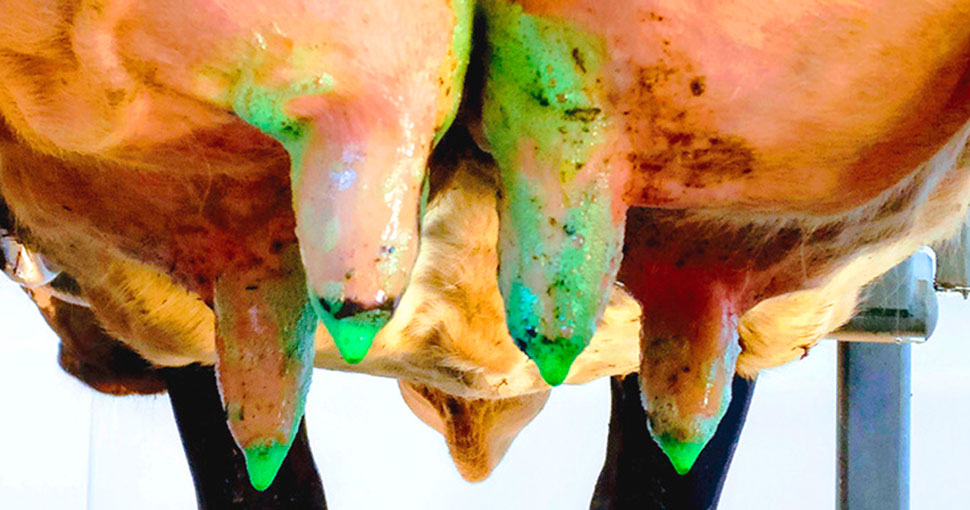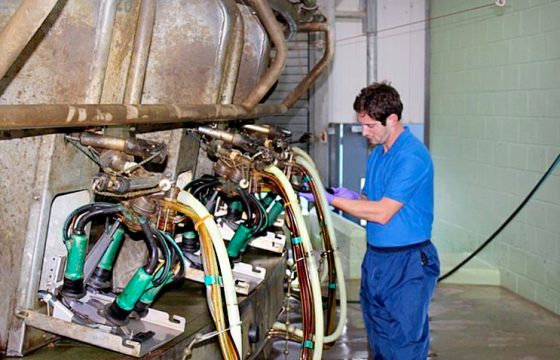How to choose the best teat dip for your farm or client?
Finally! We’ve heard you and we did it! In a series of 6 blog entries, we will explore different aspects of the teat dip. Covering some simple theories to looking at how the teat dip formulation differs from perceptions. Nevertheless the teat dip plays an integral role in udder health as it bridges some of the pillars of mastitis management (environment, milking routine, milking machine and cow).
ABOUT TEAT DIP
The use of a teat dip has been a common practice since the early 1900s to try improve udder hygiene, but in fact a teat dip has multiple functions.
Source: CEETAL Laboratoires, hygiene for dairy farms.
The different ingredients (disinfectants, surfactants, solvents, emollients, sealants, carriers and colourants) allow for variations and different combinations to be developed to target different problems (environmental and contagious pathogens) while addressing/counteracting certain negative conditions (weather, skin condition, etc.) associated with mastitis. (Watters, R., 2011).
The efficacy and safety of these products are important, but knowing the truth about perceived product failure and the potential complications that can occur (irritation to the skin, contamination of the milk, etc.) with the incorrect use, mixture and application of the teat dips is much more important.
ARE WE ACTUALLY PICKING THE RIGHT PRODUCT?
As the simple act of rinsing/washing and drying the teats (individual towels) is known to reduce the bacterial counts on the skin of the teats, but we need to optimise this efficiently to maintain the highest hygiene possible! Teat dips provide us with just such a tool.
THE BEST PRODUCT IS NOT ALWAYS THE ONE WITH THE HIGHEST CONCENTRATION (or the one with the most competitive price), but it is the one- or the correct combination of products- that works within your management system.
To ensure this is achievable we need to ask the following questions:
- What active ingredient is best (Iodine, Chlorine dioxide, etc.)?
- To home mix or to use ready mixed (RTU) solutions?
- What concentration is best?
- How to apply the teat dip? (Dip cups, sprays, chemically treated wipes or none)
- What is the current teat condition? (Milking machine, season, weather, etc.)
- What damage or harm can come to the cow? (Chemical interactions, human errors, etc.)
- What is the price?
Some of the answers to these questions can be answered just by looking at the level of management and others can be answered by using a goal orientated approach (knowing what the problem is and where you want to go).
Meaning to be present in the parlour and monitor the condition of the animals (teat end scores, skin condition, grade the clinical cases, etc.).
This is important because poor milking hygiene accounts for cows suffering from subclinical and clinical mastitis which is one of the highest economical losses for the dairy farmer and results in reduced milk volumes and lower quality milk [lower protein, butter fat and high Somatic Cell Counts (SCC)] being produced (Gleeson, D., et al., 2009).
The basic principal is that the pre and post milking teat dips are formulated to be fast and effective in washing (removing organic material) and disinfecting of the teats prior to milking (environmental pathogens) as well as protecting the teats/udders from infections (contagious and environmental pathogens) during and after milking.
TEAT DIP: MAINTAINING THE CORRECT CONDITION OF THE SKIN
The other function is to aid in maintaining the correct condition of the skin.
In this way, with the correct use of the teat dips (concentration, teat coverage, contact time, etc.) the rate of new intramammary infections will be reduced and controlled.
The image below depicts the correct application of a foaming teat dip providing good coverage from the tip to the base, which will aid in cleaning and disinfecting the teat in preparation for milking.
It is this very important fact that the effectiveness of the teat dip is not just based on the active, but rather the combinations of all the properties of the different parts of the teat dips (detergent, drying rates, residuals, film forming or foaming action and the viscosity of the solution due to emollients, etc.) and the correct application within a series of steps in an appropriate milking routines (pre and post milking).
This is because it is not as it appears at first glance e.g. the surfactant type in an iodine based teat dip, had more of a positive effect on the improvement of the skin condition compared to the glycerine concentration (Hemling, T. et al., 2002 ).
The goal is to select the right combo to ensure the best results are achieved as not all teat dips are created equal and the efficiency of the parlour needs to be maintained.
Author:




